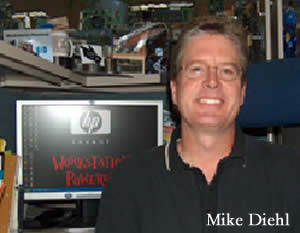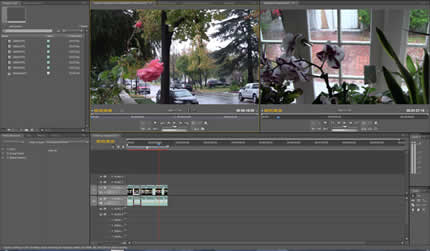 This is our first article in a series of interviews and reviews focusing on Digital Film Editing. Cinema Without Borders proudly starts this series by interviewing Mike Diehl, an expert on hardware from Hewlett-Packard.
This is our first article in a series of interviews and reviews focusing on Digital Film Editing. Cinema Without Borders proudly starts this series by interviewing Mike Diehl, an expert on hardware from Hewlett-Packard.
Mike Diehl is a product manager for the personal workstation business at Hewlett-Packard’s Workstation Global Business Unit. Mike is responsible for the feature definition and life cycle management for HP’s high-end workstation platforms.
During his 24+ years at HP, Mike has had a diverse set of assignments in both R&D; and Marketing. He was a lead architect and engineer in HP’s workstation R&D; lab. This included the definition and design of custom integrated circuits for HP’s graphics accelerators. In the late 1990’s Mike transitioned to Marketing to fulfill his passion of focusing on customer requirements, developing customer intimacy and producing workstation products that are industry leadership.
Mike is a graduate of the University of Colorado where he earned his B.S. in Electrical Engineering and has been awarded 7 US Patents. He lives in Fort Collins, Colorado and enjoys bicycling and video editing.
Cinema Without Borders: There are a lot of people that are making short films and they are always looking for affordable systems that allow them to do video and sound editing; a lot of them use HD consumer cameras, in order to have a high quality version for film festivals and a low quality version for their PC’s. A lot of the filmmakers have realized that the consumer brand products are not doing the job to their liking. My question is; are there any consumer targeted computers that can be used for these kinds of jobs?
Mike Diehl: The video editing work flow, specifically when producing HD videos, creates heavy demands on the system beyond what a consumer-brand computer typically has the capability of providing. The entire production work flow —from importing the video from tape/memory card, video editing through the creation of a DVD or Blu-Ray Disc is a very CPU and CPU-memory intensive process. The consumer cameras today use compression techniques to capture the HD video stream. In order to display these compressed HD video streams on the computer, the video needs to go through a complicated decompression process. This places a high demand on not only your CPU but also on the rest of the system infrastructure as well; most notably the memory.
 CWB: A common mistake that many people make is in thinking that the graphics card alone is all that is required to have smooth video editing; but in fact there are many other factors that contribute including memory, and the actual CPU. There are consumer computers, that come with low end graphic cards or Intel integrated graphic chips and they are not actually helping in terms of editing. So what would be your advice to people who are looking to improve their video editing speed on their computer?
CWB: A common mistake that many people make is in thinking that the graphics card alone is all that is required to have smooth video editing; but in fact there are many other factors that contribute including memory, and the actual CPU. There are consumer computers, that come with low end graphic cards or Intel integrated graphic chips and they are not actually helping in terms of editing. So what would be your advice to people who are looking to improve their video editing speed on their computer?
MD: The video editing work flow produces the highest demand on the CPU, Memory and Hard Drives. These system demands increase dramatically when the video is HD. The HD production workflow also takes advantage of as many processor cores as is provided. My advice would be to invest as much as you can afford in the CPU and memory. At a very minimum a 4-core processor and 6-8GB of system memory along with a 64-bit operating system is recommended. When previewing or rendering HD video, the application (e.g. Adobe Premiere CS4) can utilize all the processor cores that are available. Thus increasing the number of processor cores has an almost linear effect on overall performance – doubling the number of processor cores will reduce the rendering time almost in half.
CWB: Affordable, has a different meaning to different people, some consider affordable a system that cost near $1,200 while some consider an affordable system to be $3,500. I know that HP is making Z series systems workstations, could you tell us how flexible and affordable they are.
MD: HP offers an extremely broad range of workstation platforms. Our workstation portfolio is comprised of a four tier product offering. The reason why we offer such a broad range of workstation platforms is because there are so many different needs among our customers across many different market segments. At the Mainstream Value segment, we have the Z200 platform, at the Mainstream Performance segment we have the Z400, at our mid-range we have the dual-processor socket Z600, and the high end we have the Z800. The capabilities vary across these products in terms of  expandability for CPU, memory, disc and graphics. The prices start below $800 and increase from there making all of our workstations affordable.
expandability for CPU, memory, disc and graphics. The prices start below $800 and increase from there making all of our workstations affordable.
CWB: What advancements has HP made to improve the rendering times that many artists have to deal with when they are editing videos?
MD: HP is committed to provide the latest processor, graphics and surrounding technologies on our workstation platforms as these new technologies are made available in the marketplace. HP invests heavily in understanding not only how our workstations are used by our customers but also designing new technology into our systems that increase user productivity. The full-range of processors along with very large memory and disc options are provided to allow each user to configure a system that precisely matches their requirements.
CWB: After talking to our readers’ one advancement that they would like to see would be to have the ability to preview their edited work without having to first render the edited sequences. Which one of your systems could perform this task and what would be the price range for that?
MD: As discussed earlier, the HD video editing work flow is an extremely compute-intensive process. The predominant reason for not realizing real-time previews is using an under-powered or improperly configured (in terms of CPU, memory, Operating System) computer. In the video editing work flow, as clip transitions, effects (slow motion, color correction, blurs etc) and additional video layers are added, the computational demand placed on the system increases dramatically. HP provides a wide range of workstations with the intent of matching a system to the user’s requirements. A person doing HD editing using a minimal number of clip transitions and effects using a single video layer, could go with the Z400 which starts at below 1,000 dollars. As the number of clip transitions, slow-motion and other effects are increased or when adding 2-3 video layers for compositing, the demands placed on the system go beyond what an entry workstation can handle with respect to real-time previews. When you advance into these more complicated productions, that’s where much greater processing capability is required and this is where a dual socket workstation will pay great dividends in user productivity and time-to-market. The Z600 is HP’s advanced dual-socket mid-range workstation which starts in the $1600 range.
CWB: Another nightmare that customers face would be the manual addition of a HD or memory. How easy is it to make adjustments to the Z series work stations?  MD: Our HP workstations have all been designed to be completely tool free which means that there are no screwdrivers or tools necessary to remove or replace components; everything can be done by hand. We have made the systems where the cables are hidden, the power supply and hard drives are completely cable fee and everything is very modular. So, even for a first time user, adding memory and video cards is incredibly simple. In terms of upgrading, users are not tied down to ordering pre-configured skews; they can order something as highly configured or as minimally configured as they want. Custom configurability is provided to perfectly match each user’s requirements.
MD: Our HP workstations have all been designed to be completely tool free which means that there are no screwdrivers or tools necessary to remove or replace components; everything can be done by hand. We have made the systems where the cables are hidden, the power supply and hard drives are completely cable fee and everything is very modular. So, even for a first time user, adding memory and video cards is incredibly simple. In terms of upgrading, users are not tied down to ordering pre-configured skews; they can order something as highly configured or as minimally configured as they want. Custom configurability is provided to perfectly match each user’s requirements.
CWB: What advancements has HP made to get rid of fan noise?
MD: A high-level of system noise has the effect of decreasing end-user productivity. We have made acoustic improvements with each generation of our workstation platforms, but it becomes more difficult as the processor and other components become more powerful. With the design of the new Z series workstations we placed a very high level of focus on acoustics. The result is that were able to design a system that was very acoustic friendly resulting in very happy customers. We have also implemented liquid cooling into our workstations that eliminates the cooling fans typically used on the processors. This elimination of cooling fans provides even further reduction in acoustic levels, enhancing even further the productivity of our customers.
CWB: Thank you for your time.

